Are you trying to decide between TeamDynamix vs. SolarWinds for your IT Service Management (ITSM) needs? With so many choices in the ITSM landscape, finding the perfect platform to meet your organization's unique needs can feel like a daunting task.
In this blog post, we're here to provide you with an in-depth ITSM tools comparison of these two prominent ITSM players.
However, neither of these platforms may perfectly align with your specific needs. That's why we'll introduce an alternative solution: InvGate Service Management. This robust service desk software has compelling features designed to empower your organization to excel in its IT operations.


Table of contents
- TL;DR
- What is TeamDynamix?
- What is SolarWinds?
- Considering InvGate Service Management as an ITSM solution alternative
TL;DR
- TeamDynamix excels in delivering customized solutions with an intuitive interface and reliable ticketing system. However, it faces challenges in integrating with other systems, managing tickets, and its outdated user interface.
- SolarWinds is renowned for its comprehensive ITSM features and user-friendly interface, offering a seamless experience with customizable options that enhance efficiency. However, users may face hurdles during the initial setup, integration process, dealing with complex workflows, and generating reports.
- InvGate Service Management stands out with its exceptional ticketing system, user-friendly interface, cost-effective solutions, and remarkable IT Asset Management capabilities.
We tried to be as thorough as possible, but if you don't have enough time to read it through and through, here's (another) TL;DR: InvGate Service Management can do everything we say here, and you can test it right away for free for 30 days.
Most looked-at features by buyers
When users assess their options for IT Service Management solutions, they typically concentrate on specific features that align with their organization's requirements. Understanding these desired features is essential for making well-informed decisions.
Let's look at the key factors that potential buyers commonly consider when comparing ITSM tools.
- Scalability and customization - Organizations with evolving requirements prioritize solutions that can adapt to their growth and allow customization. Buyers specifically look for the ability to create custom fields, workflows, and extensions/plugins to meet their unique business needs.
- User-friendly experience and interface - Ease of use and interface design are top considerations for buyers. They highly value a user-friendly platform with an intuitive interface that boosts user adoption and overall productivity. Mobile accessibility is particularly vital, especially for remote or mobile workforce organizations.
- Ticket Management System - Prospective buyers place significant importance on seamlessly integrating a robust Ticket Management system into their help desk software. This functionality enables efficient tracking, assignment, and resolution of customer inquiries and support requests.
- Cost and support - Buyers assess the overall cost-effectiveness of the solution, considering licensing models, subscription plans, and any additional expenses related to features or users. The availability of reliable customer support, comprehensive documentation, and accessible training resources significantly influences their decision-making.
- Adaptability - Buyers prefer software solutions that can be customized to align with their unique business needs. This ensures that the software accommodates their specific workflows and processes, ultimately increasing user satisfaction and operational efficiency.
- Self-service portal and knowledge base - Including a self-service portal is highly valued as it empowers end-users to independently address common issues and access relevant information without requiring direct assistance.
- Support automation and Workflow Management - Buyers seek software solutions with automation capabilities to streamline routine tasks such as ticket routing, approvals, and escalations. These automation features contribute to increased efficiency and productivity.
- Simplified IT service catalog - Many organizations seek a simplified IT service catalog that offers a centralized platform for users to request specific IT services or resources. This streamlines service requests, enhances visibility, and aids in efficiently managing service delivery.
- Informative reporting - Buyers actively seek help desk software equipped with robust reporting tools, including dashboards and reports. These features provide valuable insights into IT operations and performance, facilitating informed decision-making and continuous service improvement.
- Seamless integration capabilities - The ability to seamlessly integrate with other systems and applications is a vital requirement for buyers. They value seamless data flow and automated processes, with a focus on the capability to integrate with existing tools and platforms to enhance efficiency and provide a unified user experience.
- Efficient IT Asset Management - Users prioritize software that offers robust IT Asset Management capabilities, aiding in maintaining accurate inventories and optimizing resource utilization within their organizations.
- ITIL compliance - Many organizations prioritize adherence to ITIL (Information Technology Infrastructure Library) best practices. Therefore, buyers may favor solutions that support ITIL processes, including Incident Management, Problem Management, Change Management, and Asset Management.
What is TeamDynamix?
TeamDynamix is a cloud-based solution that functions within the domains of IT Service Management, Project Portfolio Management (PPM), and Integration Platform as a Service (iPaaS), all delivered through a Software-as-a-Service (SaaS) model. This technology enables educational institutions such as colleges, universities, and other organizations to harmonize, work together on, and enhance their operational processes.
What users like from TeamDynamix
TeamDynamix has garnered positive user feedback from reputable industry experts, including Gartner. These assessments highlight several notable strengths and advantages of the platform. Let's take a closer look at these benefits.
- User-friendly interface - TeamDynamix features an intuitive interface that simplifies task assignment, management, and request submission. Users find it exceptionally easy to navigate, which enhances their daily task efficiency.
- Reliable ticketing module - The ticketing module consistently receives praise for its stability and dependability. It equips users with the tools to efficiently organize and track project tickets, streamlining project management efforts.
- Customization options - Users value the extensive customization options offered by TeamDynamix. These options empower them to tailor the platform precisely to their specific needs, allowing for the creation of customized workflows and processes.
- Effortless implementation - The platform is known for its easy implementation process, requiring no prior programming expertise. This accessibility reduces entry barriers for organizations, ensuring a straightforward onboarding experience.
- Powerful dashboards - TeamDynamix provides robust dashboards equipped with potent management tools. These dashboards enable seamless monitoring and collaboration among team members, ultimately increasing productivity.
- Responsive customer support - Users consistently commend the responsiveness and helpfulness of TeamDynamix's support team. They receive timely assistance when facing challenges or seeking guidance, contributing to a smoother overall user experience.
What users don’t like from TeamDynamix
Although TeamDynamix has many strengths and positive attributes, it has not escaped criticism from its user base. These criticisms have emerged through reviews conducted by reputable sources such as Gartner. Let's explore the key issues that have arisen and deserve attention:
- Complex user interface - TeamDynamix's user interface has been criticized for being overly intricate. Users have reported problems stemming from an outdated layout, limited customization options, and awkward ticket and comment layouts. Many are calling for a more modern and user-friendly graphical user interface (GUI).
- Ticket Management challenges - Users have faced various difficulties in managing tickets. These include the inability to organize tickets by their due dates, issues with the workflow designer, and the absence of essential features like batch deletion in Asset Management.
- Integration with ITSM suites - Users have expressed frustration with the platform's inability to seamlessly integrate with a comprehensive IT Service Management (ITSM) suite. Additionally, they have noted a lack of robust Change and Configuration Management software.
- Complex workflow structures - TeamDynamix has faced criticism for its intricate workflow structures, which have posed navigation and implementation challenges for some users.
- Reporting limitations - Some users have found the system's reporting capabilities to be lacking. They wish for deeper integration between project and ticketing applications to enhance their ability to create and analyze reports effectively.
- Limited desktop sharing and updates - Concerns have arisen regarding the platform's inability to facilitate desktop sharing and its infrequent updates once rolled out. This limitation has constrained flexibility and usability for certain organizations.
- Permissions management challenges - Reports have surfaced about difficulties in how the vendor manages to write/view/access permissions. These challenges have resulted in concerns related to user access and security.
- Delayed enhancement addressing - Users have expressed frustration with prolonged wait times for enhancements to be addressed, impacting their ability to utilize the platform effectively.
- Limited support - A significant drawback that has gained attention is the platform's inadequate support during critical outages. Users have reported feeling left without assistance during crucial downtime situations. Furthermore, some have expressed dissatisfaction with the level of support provided through direct channels.
- Outage page accessibility - Requiring login to access the outage page has been seen as a hindrance, preventing users from obtaining critical information during system downtime.
- User experience enhancement needed - Although generally considered user-friendly, some users have encountered challenges in their overall experience. Specifically, sorting and searching for tickets have been less intuitive, and the abundance of customization options has overwhelmed some users.
What’s TeamDynamix’s argument over SolarWinds?
In evaluating TeamDynamix in comparison to SolarWinds, it's important to delve into the distinct advantages that TeamDynamix brings as a robust IT Service Management solution.
- User-friendly interface - TeamDynamix offers an intuitive interface for streamlined task management.
- Reliable ticketing - TeamDynamix's ticketing module is known for its stability.
- Customization options - TeamDynamix offers extensive customization, tailoring workflows to your needs.
- Effortless implementation - TeamDynamix's easy implementation suits non-technical users.
- Powerful dashboards - TeamDynamix's robust dashboards enhance collaboration and productivity.
- Responsive support - TeamDynamix's support is praised for responsiveness, contributing to a smoother user experience.
What is SolarWinds?
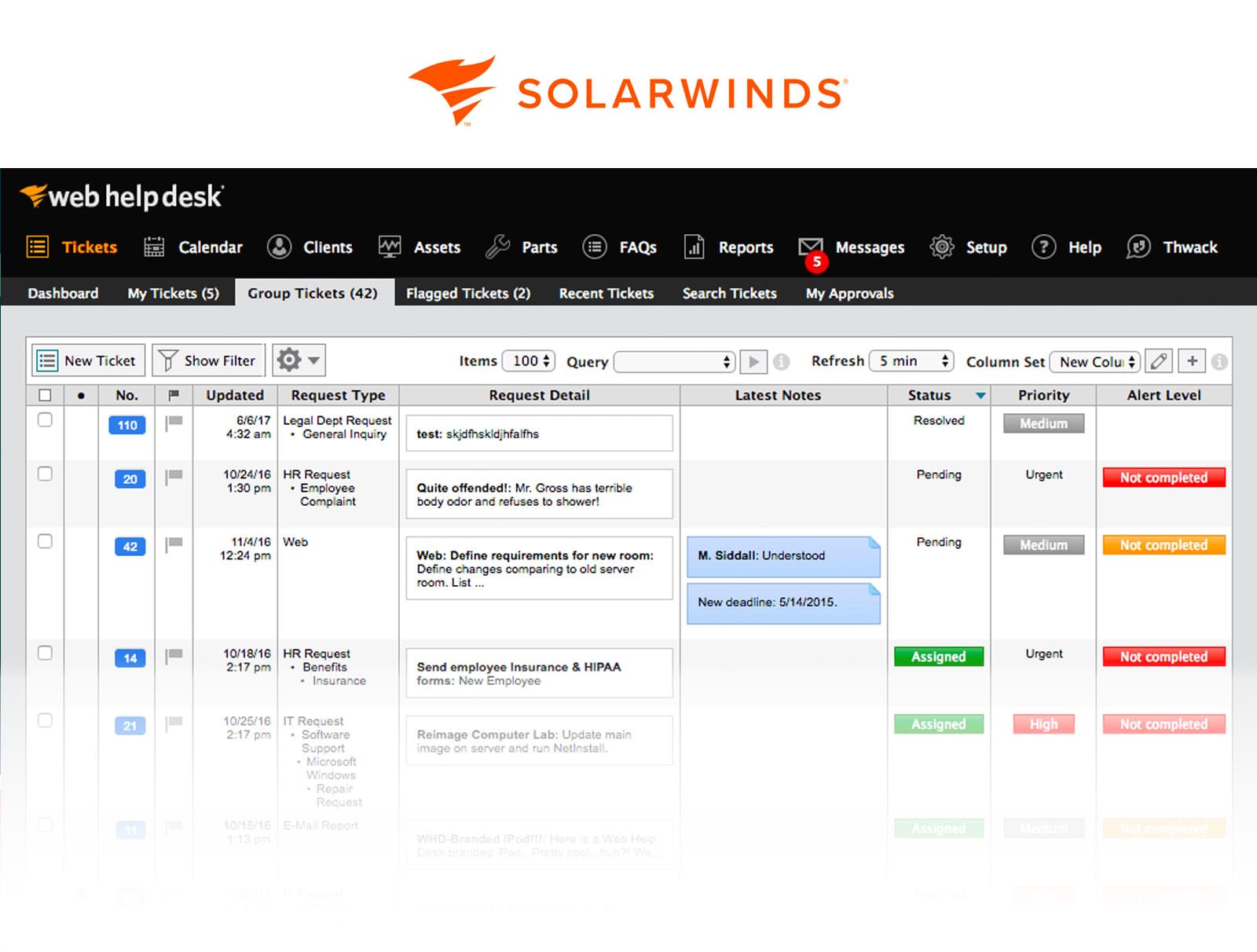
SolarWinds Corporation primarily focuses on developing software designed to manage IT systems. Their main product is SolarWinds Service Desk, a cloud-based solution to simplify IT Service Management. This platform offers various features and tools to improve IT operations' effectiveness and increase productivity. These capabilities include automation features, self-service options, tools for handling IT assets, and the ability to connect with other systems. The platform is organized into separate sections that deal with incidents, problems, releases, and changes, and it also includes a Configuration Management Database (CMDB). Platform users can create customized reports to gain valuable insights into their IT operations.
What users like from SolarWinds
SolarWinds Service Desk has received positive feedback from users, as evidenced by reviews from Gartner. Let's explore the benefits highlighted by both customers and experts.
- Comprehensive ITSM features - Users express satisfaction with the platform's extensive range of features, including Incident Management, Problem Management, Change Management, Asset Management, and a service catalog. The platform is highly regarded for its all-encompassing nature.
- User-friendly interface and experience - Users consistently praise the platform for its user-friendly interface and easy navigation, making it accessible and accommodating for individuals with varying levels of technical expertise.
- Improved efficiency and productivity - Users have reported significant improvements in efficiency and productivity due to the software's capacity to streamline IT operations and facilitate effective incident resolution processes.
- Customization and integration opportunities - Users appreciate the available customization options, which allow them to tailor the platform to their specific needs. Furthermore, the platform's ability to integrate with other tools and services has received high acclaim.
- Effective ITAM - Users highly value the software's Asset Management capabilities, which enable efficient tracking of hardware, software, licenses, and contracts.
What users don’t like from SolarWinds
While SolarWinds Service Desk has several strengths, it has not escaped criticism from customers, as reported by reputable sources such as Gartner. Here are some of the issues that have been highlighted:
- Complex initial setup and implementation - Some users have found setting up and implementing the software to be time-consuming, particularly when it involves importing existing inventory. This suggests room for improvement in streamlining these initial steps.
- Complex workflow - Some users have noted that the software's workflow can be intricate and cumbersome. There is a demand for simpler and more streamlined processes.
- Integration with third-party apps - Users have expressed a desire for more seamless and robust integration capabilities with third-party applications within SolarWinds Service Desk.
- Limited customization - Customers have pointed out that the available customization options are somewhat restricted and could benefit from expansion to better align with their needs.
- Reporting functionality limitations - Users have indicated a need for enhanced reporting capabilities and more comprehensive analytics tools within the software to gain deeper insights.
- Localization and language support - Suggestions have been made to improve the platform's support for multiple languages and enhance localization features to cater to a more diverse user base effectively.
- Limitations in search functionality - Some users have observed shortcomings in the tool's search functionality and have suggested enhancements to make it more efficient and user-friendly.
- A desire for additional features - Users have expressed a desire for supplementary features, such as a calendar booking system, webhooks for integration purposes, and improved functionality on the mobile app.
What’s SolarWinds’s argument over TeamDynamix?
SolarWinds presents a compelling argument when compared to TeamDynamix. Here are the key advantages that make SolarWinds stand out:
- Comprehensive ITSM features - SolarWinds offers a complete suite of ITSM features, including Incident Management, Problem Management, Change Management, Asset Management, and more.
- User-friendly interface - SolarWinds provides an intuitive and user-friendly interface, ensuring accessibility for users with varying technical expertise.
- Efficiency and productivity - Users consistently report increased efficiency and productivity thanks to SolarWinds' streamlined IT operations and effective incident resolution processes.
- Customization and integration - SolarWinds allows extensive customization and seamless integration with other tools, making it adaptable to unique organizational needs.
- IT Asset Management - SolarWinds excels in IT Asset Management, efficiently tracking hardware, software, licenses, and contracts.
Considering InvGate Service Management as an ITSM solution alternative
While TeamDynamix and SolarWinds are prominent players in the IT Service Management sector, exploring alternative solutions that align with your organization's specific needs is crucial. In this context, InvGate Service Management stands out as a compelling option that warrants careful consideration.
Let's explore the comprehensive features of InvGate Service Management that make it an appealing choice for fulfilling your organization's ITSM requirements.
Simplified configuration and setup
InvGate Service Management streamlines configuration and setup through a user-friendly, no-code/low-code approach. This approach allows both novices and experienced users to implement the system without requiring extensive technical expertise. The platform offers straightforward configuration options, enabling organizations to harness its potent ITSM capabilities quickly.
Focused on ITSM with ESM extension
InvGate Service Management is purpose-built for ITSM and seamlessly extends its capabilities to Enterprise Service Management (ESM). This enables operational departments to improve their processes and fully embrace the benefits of digital transformation, facilitating streamlined workflows and comprehensive digital transformation initiatives across all departments.
Robust Ticketing and Incident Management
InvGate Service Management offers powerful capabilities for efficient ticket tracking, collaboration, and incident resolution. Features like automated ticket routing, customizable workflows, and SLA Management enable IT teams to manage and prioritize incidents effectively.
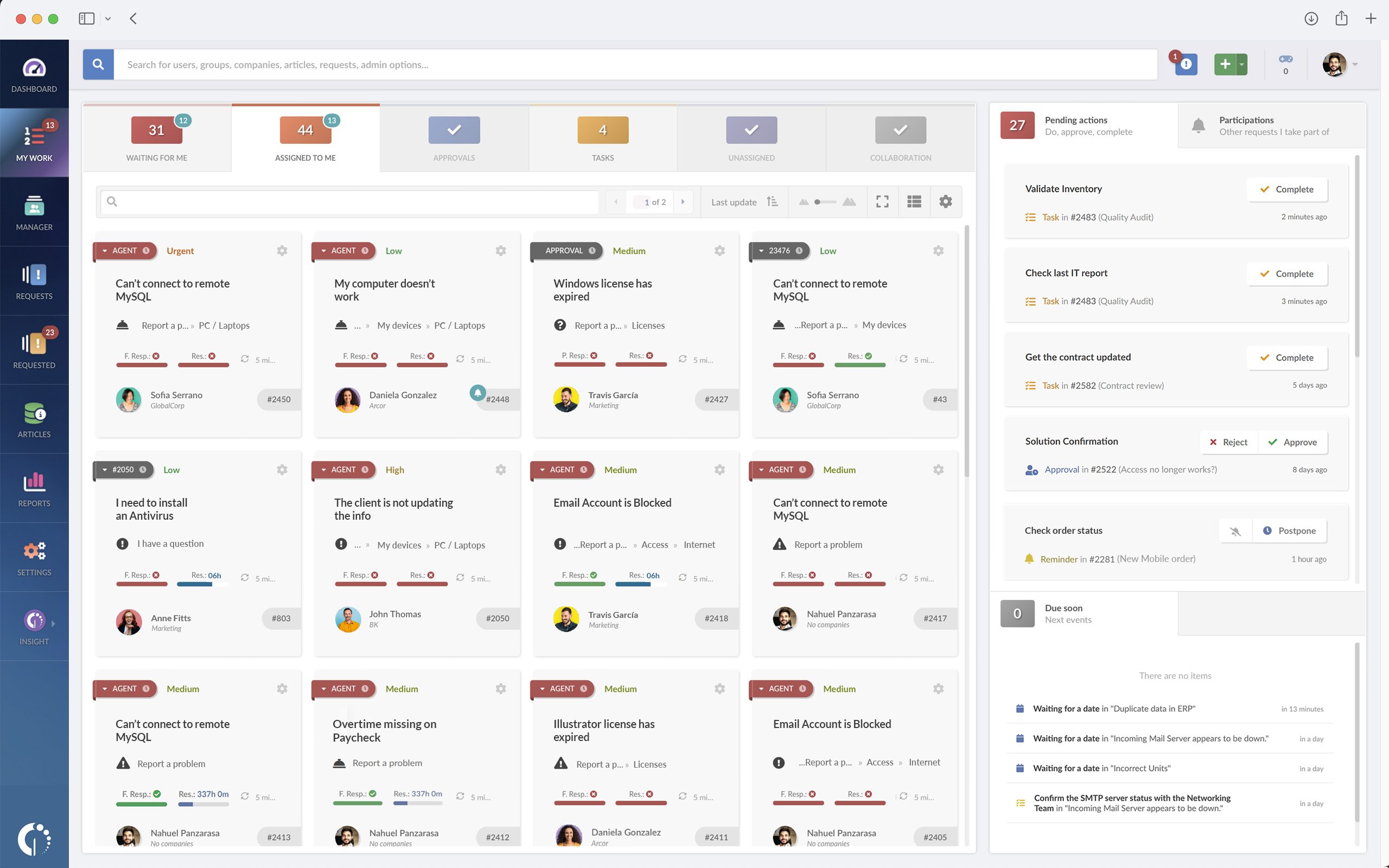
Outstanding user experience
InvGate Service Management prioritizes an exceptional user experience, achieved through meticulous design and adherence to user interface/user experience (UI/UX) best practices. Its intuitive interface promotes rapid adoption, reducing the need for extensive training and ensuring a user-friendly design that enhances productivity.
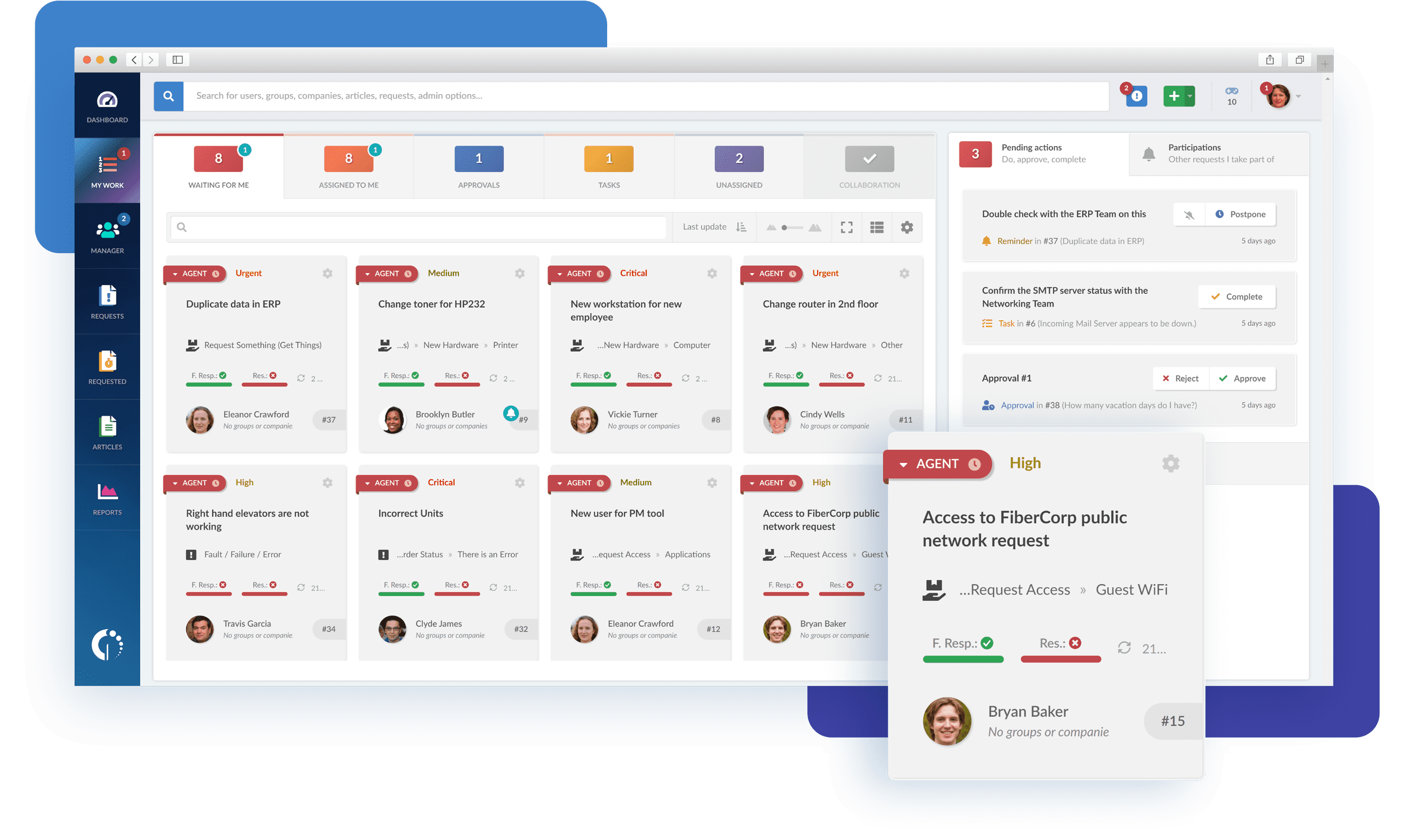
Strong self-service capabilities
InvGate Service Management provides robust self-service functionalities, including a user-friendly portal, an extensive IT service catalog, and a knowledge base. These features empower end-users to independently resolve common issues, access various IT services, and utilize self-help resources, thereby reducing the workload on IT staff.
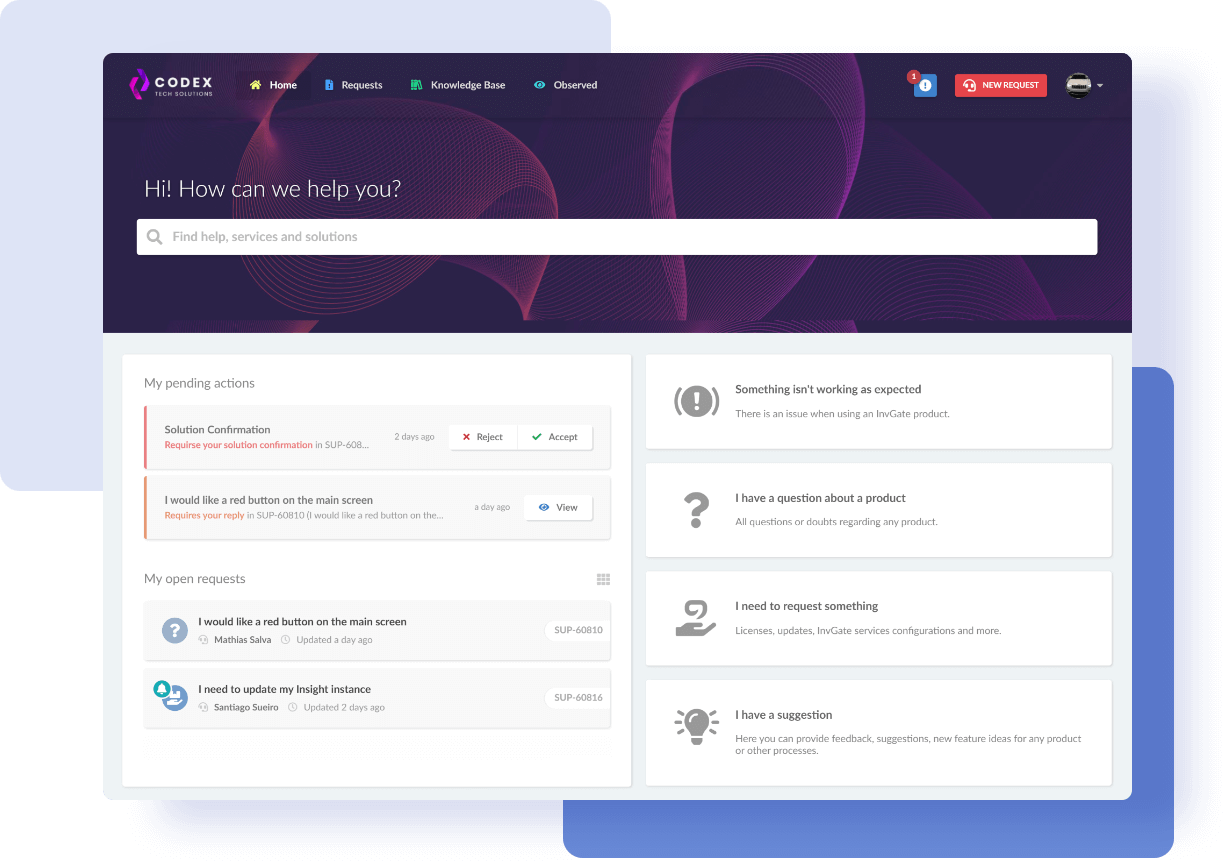
Customization and flexibility
InvGate Service Management offers flexible deployment options, allowing organizations to choose between on-premise or cloud-based solutions. This adaptability ensures that the platform can cater to the specific demands of various sectors and industries.
Comprehensive reporting and analytics
InvGate Service Management provides extensive reporting and analytics functionalities, enabling organizations to gain valuable insights into their IT operations and performance. It offers ready-to-use reports and customizable dashboards, empowering IT teams to analyze data, identify patterns, and make informed decisions to enhance their services.
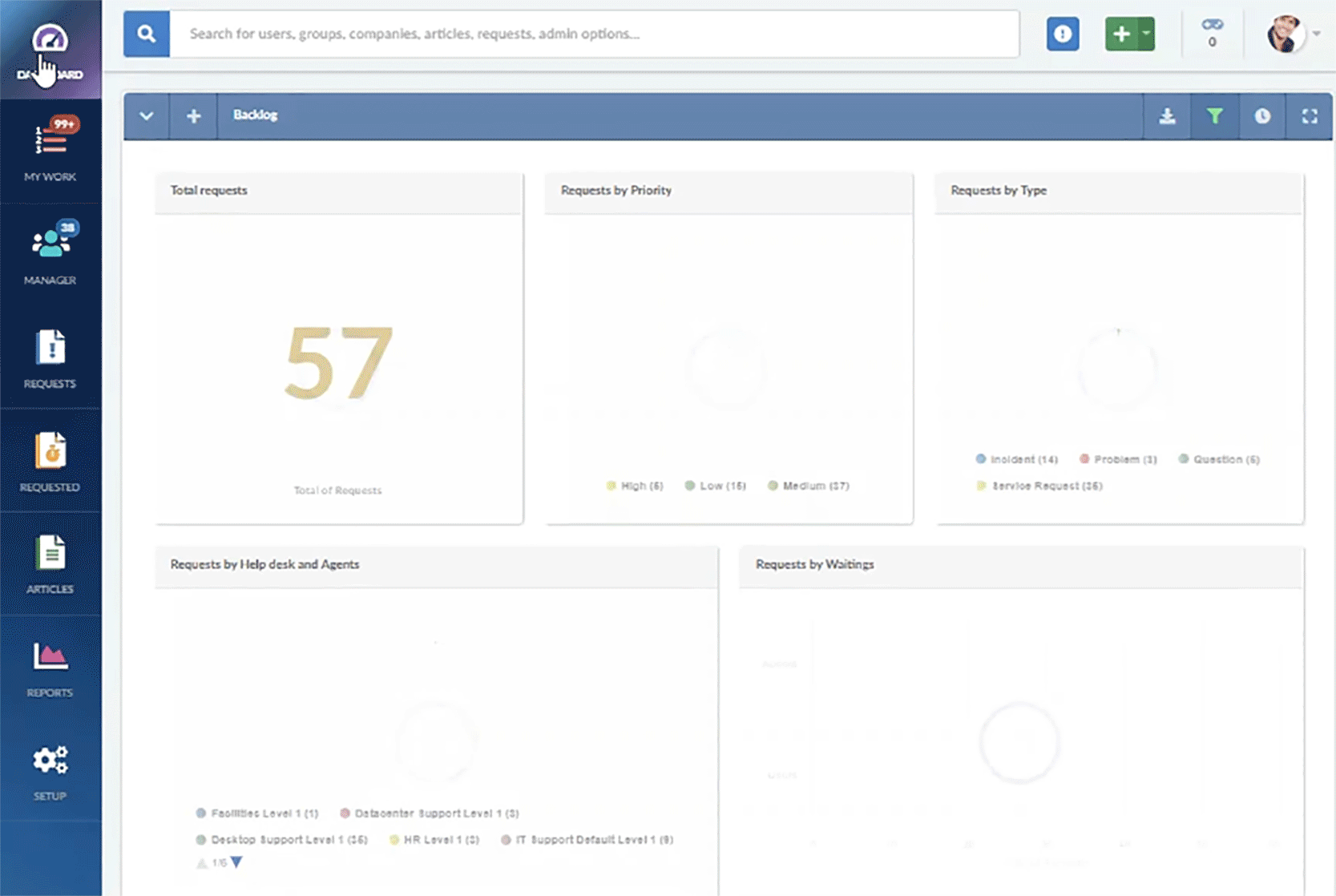
Cost-effective solution
InvGate Service Management offers a cost-effective solution without compromising functionality. It provides a comprehensive suite of ITSM features at a competitive price point, making it an attractive choice for organizations seeking affordability without sacrificing capabilities. When compared to alternatives like TeamDynamix and SolarWinds, InvGate Service Management strikes a balance between cost and functionality.
Comprehensive Asset Management
Integration with InvGate Asset Management offers organizations a comprehensive view of their IT ecosystem, enhancing service delivery and reducing downtime. InvGate Asset Management provides features such as IT Asset Discovery, Inventory Management, Software License Management, and maintenance schedules.

ITIL best practice compliance
InvGate Service Management has earned the prestigious PinkVERIFIED Certified certification, showcasing its commitment to upholding ITSM excellence. Whether organizations are embarking on their ITIL journey or managing complex operations, InvGate Service Management offers a user-friendly and feature-rich experience aligned with industry best practices.
Fast ROI and ongoing innovation
InvGate Service Management ensures a rapid return on investment through efficient implementation processes. Within weeks, organizations can start benefiting from this robust ITSM solution. Additionally, regular feature updates keep users at the forefront of technology without incurring additional costs.
Next steps
In comparing TeamDynamix vs. SolarWinds, we've delved into the strengths and weaknesses of these two IT Service Management solutions. Each has its unique offerings and advantages, catering to different organizational needs and preferences.
However, if you're searching for an alternative that can provide a comprehensive and user-friendly solution to streamline your ITSM processes, consider exploring InvGate Service Management. This platform is a robust and intuitive solution committed to optimizing IT operations.
To guide you through the selection process, check out our free ITSM implementation checklist. Making an informed decision and properly implementing it are the keys to unlocking the full benefits of your chosen ITSM solution.
















